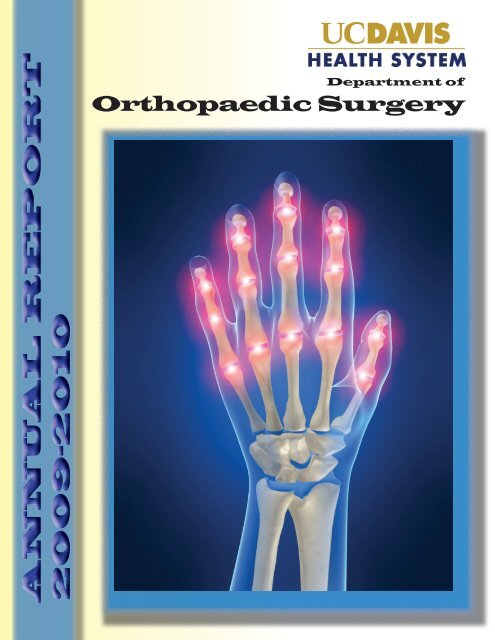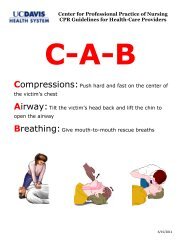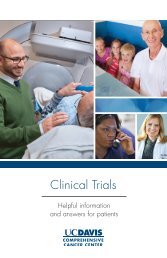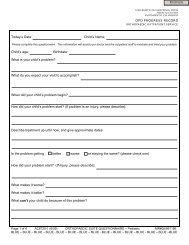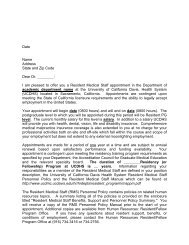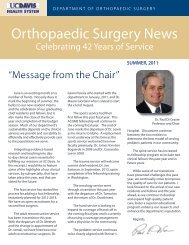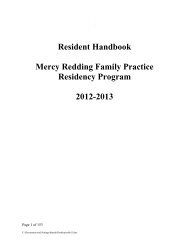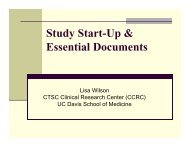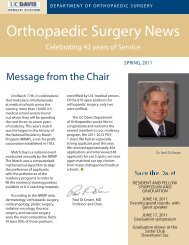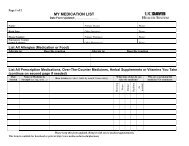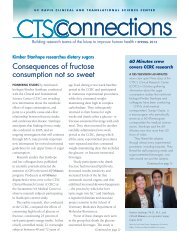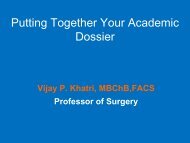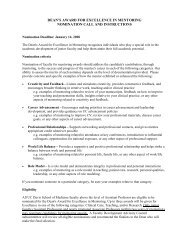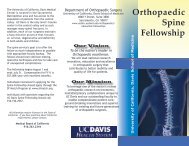2009-2010 Annual Report - UC Davis Health System
2009-2010 Annual Report - UC Davis Health System
2009-2010 Annual Report - UC Davis Health System
- No tags were found...
Create successful ePaper yourself
Turn your PDF publications into a flip-book with our unique Google optimized e-Paper software.
ANNUAL REPORT<strong>2009</strong>-<strong>2010</strong>Department ofOrthopaedic Surgery
Our VisionTo be the nation’s leader in Orthopaedic excellence.We will lead national research innovation, education and excellence in orthopaedicsurgery that contributes to better mobility and quality of life for patients.Faculty, graduate residents and fellows - June <strong>2010</strong>Our MissionTo leverage one of the nation’s richest orthopaedic research environments, multidisciplinarycollaborations unique to <strong>UC</strong> <strong>Davis</strong> and our outstanding faculty to enablecompassionate patient care, ground-breaking innovations and superior training forexisting and future generations of orthopaedic surgeons.U.S. News Best Hospitals <strong>2010</strong>-11The <strong>UC</strong> <strong>Davis</strong> Medical Center ranks among the top 50 hospitals in America,according an annual survey that was published in the August print issueof U.S. News and World <strong>Report</strong> and online at http://health.usnews.com/best-hospitals. Out of more than 5,000 hospitals nationwide, the <strong>UC</strong>D MedCenter was ranked 35th for orthopaedics and 50th for cancer.Only three other Northern California hospitals ranked in the top 50 fororthopaedics: <strong>UC</strong>SF Medical Center, Stanford Hospital and Clinics and JohnMuir Medical Center in Walnut Creek.Dr. Paul Di Cesare, medical director and chair of orthopaedic surgery at <strong>UC</strong>D, said the recognition highlightsefforts toward building a leading orthopaedic department. “The <strong>UC</strong> <strong>Davis</strong> department of orthopaedicsurgery is a leader in state-of-the-art orthopaedic surgery, research and education,” he said.The department has a Level 1 Adult Trauma Center and a musculoskeletal research center that are amongthe nation’s most sophisticated and interdisciplinary, Di Cesare added. “Our program, encompassing ninesubspecialties, a 24-hour Level 1 Trauma Center and Shriner’s Children’s Hospital, plus access to the latestclinical research trials, ensures one-stop coverage and the best available care,” he said.Follow us on
Progress <strong>Report</strong> from the ChairPaul E. DiCesare, MD, FACSMichael W. Chapman ChairWhen reflecting on this past fiscal year, July <strong>2009</strong> - June <strong>2010</strong>, the summation istwo words: mission viability. In a climate of economic uncertainty and healthcarereform, we were faced with new realities and called upon to capitalize on opportunitiesto reinvent ourselves as a department while staying true to our identity. Implementingnew processes can be challenging. However, we have not only weathered, butexceeded expectation during the transitions of the past year, and have positionedourselves to prosper as we continue to face future times of transition for years to come.In order to have a viable clinical division, fiscal year <strong>2010</strong> focused on the clinicalaspect of our mission. There was great effort involved in looking for opportunities tostreamline processes, enhance revenues, educate physicians regarding documentation,reduce costs, and most importantly, provide a more favorable environment for ourpatients to receive care and for our staff, faculty and trainees to work and practiceorthopaedic medicine. In January <strong>2010</strong>, April Hillard, our new practice manager,joined our team and has been charged with spearheading numerous initiatives. As a result of everyone’sinvolvement in helping to improve the clinic experience, our patient satisfaction scores have notably improved!This is a great affirmation that our disciplined work and relentless energy is positively effecting our patients.In an effort to ensure that members of the department were sharing a congruent message about the myriad ofservices we provide, and were aligned with our four key missions: clinical, community engagement, educationand research, our faculty participated in a series of discussions and a vision planning workshop hosted by anoutside facilitator. Our end product was a succinct vision, mission, and key messaging statement. We hope toutilize our newly defined words by continually engaging members of our community through dynamicconversations, communication mediums, and development activities.September marked the implementation of a new educational offering: resident preparation for the orthopaedicin-trainingexamination. Residents attended weekly sessions focusing on subspecialty content taught by faculty.In January <strong>2010</strong>, we were pleased to learn that our residency program was approved to increase from four tofive permanent slots per year, bringing the total of residents in our program to twenty five. This past fiscal year,the Doctors Research and Education Fund (DERF) was established. Funded by faculty donations, traineeshave the opportunity to apply, with the support of a faculty investigator, for funds to promote their education orresearch endeavors.A focus for our research mission was strengthening our relationship with the Bioengineering Department, in aneffort to broaden our research collaboration within the <strong>UC</strong> <strong>Davis</strong> community and create a viable partnership thatis aligned with the visions of both departments. In October <strong>2009</strong>, Kyriacos Athanasiou, PhD, was jointlyappointed to our department, while primarily serving as the Chair of Bioengineering. Dr. Athanasiou hasworked closely with Dr. Fyhrie to focus on the recruitment of our Doris Linn Endowed Chair vacancy that weare looking to fill in the near future. Drs. Athanasiou and Fyhrie also serve as joint faculty mentors to ournewest research faculty member, Dr. Blaine Christiansen, who joined our department in March <strong>2010</strong>. I lookforward to watching this partnership prosper in the years ahead.Mission viability is crucial to the success of our department and is the pathway for us to achieve our vision ofbeing the nation’s leader in orthopaedic excellence. In the following pages, you will see highlights from fiscal year<strong>2010</strong>. Hopefully you will appreciate as much as I do, the diversity of our faculty, staff, and trainee members andprograms.Regards,Paul Di Cesare, MDProfessor and Chair
A Message from the Lab DirectorWe continued to grow last year, increasing by four faculty and publishing actively.Joining us in the last year were Blaine Christiansen, PhD, as Assistant Professor inResidence; Jasper Yik, PhD, as Adjunct Assistant Professor; and Kyriacos Athanasiou,PhD, as Professor. Kyriakos Komvopolous, PhD, Professor, actually joined us earlyin fiscal year <strong>2010</strong>-2011.Dr. Christiansen was a postdoctoral fellow with Mary Bouxsein at the Beth IsraelHospital. He earned his PhD in bioengineering at Washington University with MattSilva. His primary research interest is in the role of mechanical loading in regulationof bone structure and strength. He is an expert in mouse and rat experimentation,biomechanical testing, histological analysis, microcomputed tomography and mostother technology used in biomechanics. He was accepted as a member of theBiomedical Engineering Graduate Group.David P. Fyhie, PhDDavid Linn Endowed ChairDr. Yik originally came to <strong>UC</strong>D Orthopaedics as a visiting postdoctoral scholar from <strong>UC</strong> Berkeley. He worksdirectly with Dr. Di Cesare to understand the cell biology of the molecule COMP (cartilage oligomeric matrixprotein) and its expression in health and arthritis. The goal is to determine the basic physiology of this importantmolecule (it is part of the system that forms the collagen fibers of cartilage) and also to determine whetherchanges in COMP expression affect the formation or degradation of cartilage during arthritis.Dr. Komvopoulos is an expert in tribology and joined the laboratory as a Professor at Berkeley. He joined thelaboratory with a WOS appointment (without salary) and works closely with Dr. Reddi on tribology of articularcartilage.Dr. Athanasiou joined as Professor with a 50% appointment in Orthopaedics and 50% in BiomedicalEngineering. He is the Chair of the Biomedical Engineering Department, has great expertise in tissue engineeringof cartilage and started five companies during his academic career, one of which sold for $75 million. His effortsinclude developing new methods to regenerate articular cartilage and he works closely with Dr. Reddi.Updating on the “oldtimers” in the laboratory:Sunny Kim is working currently on a joint registry and teaching in biostatistics. She has applied for her tenurepromotion this year.Dr. Haudenschild continues to work with Drs. Di Cesare and Reddi on tissue regeneration projects, but hisparticular interest is the mechanobiology of cartilage. Dominik filed a provisional patent on the association ofgrowth factors with COMP this year—a newly discovered function of the molecule. Derek Amanatuallah, lastyear’s Dr. Denny and Mrs. Jeanene Dickenson Resident Fellow worked closely with Dr. Haudenshild on hismechanobiology projects and obtained very interesting preliminary data. The project is continuing with theassistance of a new PhD student, Jeff Lu.Dr. Reddi was on sabbatical in Spain for part of the year and his student Stephanie Chan successfully defendedher dissertation this fall.Dr. Fyhrie’s student Matt Anderson completed his master’s in biomedical engineering this fall and joined thelaboratory as a Junior Specialist working under the supervision of Blaine Christiansen.Dr. Mark Lee’s collaborations with Dr. J. Kent Leach of biomedical engineering were successful when theyobtained two research grants totaling more than $300,000 of funding.
1A highlight of our research program is the Dr. Denny and Mrs.Jeanene Dickenson Resident Research Fellowship. Last year’s fellow,Dr. Derek Amanatuallah, worked closely with Dr. Haudenschild tounderstand the mechanical regulation of cartilage macromoleculesusing a cell culture model developed here in the Ellison Center. Dr.Joel Williams is this year’s fellow and is working closely with Dr.Mark Lee to improve fixation to heal refractory fractures.At the time of this writing, our <strong>2010</strong> Research Symposium was aweek ago. The Distinguished Guest Speaker was David Mooney, PhD,who is a Core Faculty Member of the Wyss Institute for BiologicallyInspired Engineering at Harvard University. His laboratory isfocused on the design and synthesis of microenvironments, orniches, that regulate the fate of either transplanted cell populationsor cells already resident in tissues. Dr. Mooney’s lecture (and thewhole symposium) was well attended, drawing an audience morebroadly than last year with attendance from across the campus.David P. Fyhrie, PhDProfessor and DirectorOrthopaedic Research LabLast year’s publications from the Ellison Laboratory are listed in theback of this report. The following is a list of our research sponsors:AO North AmericaAO Resident Research Grant ProgramArtimplantBiomet Orthopaedics, IncorporatedDr. Michael W. Chapman and Mrs. Elizabeth C. ChapmanDepuy Acromed, Inc.Dr. Denny Dickenson and Mrs. Jeanene DickensonMr. Lawrence J. Ellison and Mrs. Melanie Craft EllisonGlaxo Smith KlineKoret FoundationDavid and Doris LinnMedtronic, IncNational Institutes of <strong>Health</strong>OMeGA Medical Grants AssociationOrthopaedic Research and Education FoundationOrthopaedic Trauma AssociationPaul R. Lipscomb Sr. FundProcter & Gamble PharmaceuticalsShriners Hospital for ChildrenSmith & Nephew, PLCStryker Howmedica OsteonicsSynthes CorporationBen Trainer<strong>UC</strong> <strong>Davis</strong> Biology Undergraduate Scholars Program<strong>UC</strong> <strong>Davis</strong> Faculty Research Grant Program<strong>UC</strong> <strong>Davis</strong> <strong>Health</strong> <strong>System</strong> Research AwardsKyriacos A.Athanasiou, PhDDistinguished Professorof Biomedical Engineeringand Orthopaedic Surgery,Chair of Department ofBiomedical EngineeringDominik R.Haudenschild, PhDAssistant ProfessorKyriakosKomvopolous, PhDVisiting Professor, WOS,Dept of Orthopaedicsand Professor ofMechanical Engineeringat <strong>UC</strong> BerkeleyJasper H. N. Yik, PhDAdjunct ProfessorBlaine A.Christiansen, PhDAssistant ProfessorSunny H. Kim, PhDAssistant Professor,Orthopaedics ClinicalOutcomes ResearchA. Hari Reddi, PhDDistinguishedProfessor, Lawrence J.Ellison Chair ofMusculoskeletalBiology
Adult Reconstruction ServiceJohn P. Meehan, MDAssociate Clinical Professor,Chief and Fellowship DirectorPaul E. DiCesare, MDProfessor and ChairAmir A. Jamali, MDAssociate ProfessorMost people expect to remainproductive and physically fit at any age;this is especially true in northernCalifornia. The manner in which we live,work, and exercise has a dramatic impacton the quality of our lives. Our group offellowship-trained surgeons has treatedmore than 1000 patients each year. Ourservice is patient-focused and has had along history of exceptional and successfulcare.The Adult Reconstruction Service isdesigned to help patients in need ofprimary or revision hip or kneereplacement or other joint preservationprocedures. Additionally, our groupactively conducts research with theobjective of providing the best outcomesfor all our patients. We offer innovativetechnology and treatment options,including minimal incision surgery,computer-assisted surgery, hip resurfacingand arthroscopy, and state-of-the-art painmanagement strategies that speedrecovery and minimize postoperative pain.The service conducted a successful recruitof an additional Adult Reconstructionsurgeon, Dr. Gavin Pereira, who comesto us from Coventry, England, and willbe joining the department in January2011. Dr. Pereira has completedfellowships in both Trauma and AdultReconstructive Surgery.In October <strong>2009</strong>, Dr. Di Cesare wasinvited to be a guest lecturer at theDepartment of Traumatologic andOrthopaedic Surgery at the Universityof Malaga in Malaga, Spain. He servedas a member of the subcommittee thatdeveloped the AAOS Guidelines on theDiagnosis of Periprosthetic Joint Infectionsof the Hip and Knee. Dr. Di Cesarewas appointed to the Adult Reconstruction-Hip Program Subcommittee of the AAOS.He is currently serving on the searchcommittee for the Chair of the Departmentof Surgery at <strong>UC</strong> <strong>Davis</strong> <strong>Health</strong> <strong>System</strong>.Dr. Amir Jamali was program chair forfor the COA <strong>Annual</strong> Meeting QMEcourse. Dr. Jamali’s research focus is onspecialization of cartilage preservationsurgery.This past year, Dr. John Meehan wasthe recipient of an OREF FellowshipAward for $72,000, which pays salaryand benefits for our <strong>2010</strong>-2011 fellow;he also received an Omega Grant inthe amount of $30,500 to be used forthe Adult Reconstruction Fellowship.Dr. Meehan was awarded a $25,000“Vision” Grant by the <strong>UC</strong> <strong>Davis</strong> <strong>Health</strong><strong>System</strong> National Board of Advisors forhis research project “Assessing PatientOutcomes After Simultaneous BilateralTotal Knee Arthroplasty Versus StagedBilateral Total Knee Arthroplasty.”The Adult ReconstructionService concentrates onthe care of patients withmajor joint arthritis.Common referrals are forosteoarthritis,post-traumatic arthritis,avascular necrosis andarthritis secondary tohemophilia.
Foot and Ankle ServiceThe Orthopaedic Foot & Ankle Serviceat <strong>UC</strong> <strong>Davis</strong> has grown substantiallysince August 2008, when Dr. Eric Gizaassumed the position of service chief.The service now has two busy clinic andsurgery days each week.Dr. Giza continues to educate and trainthe PGY4 residents and has had numerouspublications in the past two years. Thehighlight publications include a two yearoutcomes study on cartilage transplantationin the talus, a cadaver study on Achillestendon repair with augmentation and aJournal of Bone and Joint Surgerypublication on treatment of Achilles tendonrupture.The Foot & Ankle Service began theOrthopaedic Summer Scholar program in<strong>2009</strong> by providing research opportunitiesto students interested in Orthopaedicsbetween their first and second year ofmedical school. The <strong>2009</strong> candidate hasone publication and two accepted abstracts,and the <strong>2010</strong> student has developed acadaver study protocol.The service will be expanding by addinga fellowship and second faculty memberin 2012 or 2013.Dr. Giza has participated as a facultyinstructor at the Foot and Ankle FellowsCourse in Naples, Florida in April <strong>2010</strong>.There, he instructed over 30 of the currentOrthopaedic Foot and Ankle Fellows inthe United States. In July <strong>2010</strong>, Dr. Gizapresented an abstract, gave a lecture andmoderated sessions at the AmericanOrthopaedic Foot and Ankle Society<strong>Annual</strong> meeting in Baltimore, Maryland.Dr. Giza continues to work with MajorLeague Soccer as their medical informationcoordinator. In January, 2011, Dr. Gizawill present his work on the developmentof an injury and medical record system forMajor League Soccer at the <strong>Annual</strong> SoccerIndustry Sports Medicine Symposium.Eric Giza, MDAssistant Professor andChiefThe goals of the service are to provide Sacramento and NorthernCalifornia with the highest quality of care for the diagnosis,treatment, and prevention of foot and ankle problems.Academic PersonnelActionsEffective 7/1/<strong>2009</strong>PROMOTIONSDr. Robert Allen - Assistant Professor Step 4,promoted to Associate Professor Step 1,HSCP SeriesDr. Mark Lee - Assistant Professor Step 4promoted to Associate Professor Step 1,Clinical X SeriesMERITDr. Paul Di Cesare - Rank Professor,Regular Series, Current Step 3Dr. Eric Klineberg - Rank Assistant Professor,Clinical X Series, Current Step 3Dr. Richard Marder - Rank Professor,HSCP Series, Current Step 5Dr. Debra Popejoy - Rank Assistant Professor,Clinical X Series, Current Step 3Dr. Roberto Rolando - Assistant Professor Step4 Clinical X Series to Assistant Professor Step 5HSCP Series (note change in series)/ Student Data Totalling 105FY10 Faculty & StudentData Totaling 10523Faculty MD44Faculty PhDFellows7Residents6 Students24
Hand and Upper Extremity ServiceRobert M. Szabo, MD, MPHProfessor, Chief andFellowship DirectorRobert H. Allen, MDAssociate Clinical ProfessorThe intricate design and frequent useof our hands and upper extremities eachday makes this part of our bodies highlysusceptible to injury and disease. The<strong>UC</strong> <strong>Davis</strong> Orthopaedic Hand & UpperExtremity Service specializes in treatingpatients with common and complex,traumatic and acquired disorders of thehand and upper extremity. Our teamcombines the best in clinic, educationand research for our patients.We have experience and expertise in a widerange of conditions, such as arthritis ofthe hand; trigger finger; fingertip injuriesand amputations; intersection syndrome;DeQuervain’s tenosynovitis; compresssionneuropathies; Dupuytren’s Disease; tumorsof the hand; and the hand in cerebral palsy,just to name a few. Common proceduresperformed are brachial plexus and peripheralnerve surgery; congenital deformities,including Ilizarov reconstructions; shoulder,elbow and wrist joint replacements; wristreconstruction, including arthroscopy;tumors; and microvascular reconstructivefree tissue transfers.The Hand & Upper Extremity Serviceattracts patients from the entirety ofnorthern California, southern Oregon,and western Nevada, with private patientstraveling from New York, New Orleans,Washington State and Mexico. The serviceperforms over 600 procedures each year.We have a strong relationship with theJapanese orthopaedic and hand surgerycommunity. Hand Service faculty havebeen invited to lecture in Japan on twoseparate occasions. In September <strong>2009</strong>,two ASSH International Japanese TravelingFellows visited our service. In addition, adistinguished Japanese hand surgeon fromKagawa came to observe Dr. Szabo for theentire month of November <strong>2009</strong>. The onlyother centers this surgeon visited in the USwere the Mayo Clinic and Harvard.Our primary research focus, both clinicallyand in the laboratory, is on nerve compressionsyndromes. A major emphasis on earlylaboratory efforts has focused on examiningthe effect of compression on the tibial nerveon a rat model. Specific aim had been tocharacterize the response of peripheralnerves to intermittent compression with agoal of understanding the role of repetitivemotion, as seen in cumulative trauma, inthe pathophysiology of nerve compression.In the laboratory, an animal model wasdeveloped to study end-to-side nerveregeneration through silicone tubules andexamine the effects of growth factors onnerve regeneration and repair. Anotherresearch focus is biomechanics of fracturefixation specifically with determining therole of locking, non-locking and hybridfixation in the hand. In addition, Dr. Szabohas a strong interest in clinical researchdesign and outcome studies that can contributeto the foundation of evidence-based medicine.The following are highlights for the pastfiscal year:• In March <strong>2010</strong>, the Hand Service wasawarded a fellowship grant for $25,000from the Orthopaedic Research andEducation Foundation (OREF) forfellowship year <strong>2010</strong>-2011.• Dr. Szabo assumed the role of Presidentof the Americfan Society for Surgery ofthe Hand (ASSH) in September <strong>2009</strong>.He will serve until October <strong>2010</strong> andwill preside over the 65th <strong>Annual</strong> ASSHMeeting in Boston, MA, October 7-9.• In September <strong>2009</strong>, Dr. Szabo receivedan Honorary Member Award from theAmerican Society of Hand Therapists(ASHT).• Dr. Szabo was recognized as one ofAmerican’s Top Doctors for Cancerby Castle Connolly Medical, Ltd. inNovember <strong>2009</strong>.• In April <strong>2010</strong>, Dr. Szabo was recognizedfor his distinguished contributions as aspeaker at the 53rd <strong>Annual</strong> Meeting ofthe Japanese Society for Surgery of theHand (JSSH).
Oncology ServiceThe <strong>UC</strong> <strong>Davis</strong> Orthopaedic OncologyService is dedicated to providing care forboth children and adults with primarybenign and malignant tumors within boneor soft tissues. The service pursuesaggressive treatment of metastatic skeletallesions to prevent threatened fracture or tostabilize completed fractures. The primarythrust is in the area of limb salvage formalignant tumors of the extremities.In September 2008, Dr. Robert Tamurianassumed the role of chief of the service.Since then, the oncology practice hasexperienced sustainable growth, servingpatients from northwest Nevada,southwest Oregon, and all of northernCalifornia. Dr. Tamurian routinelyschedules about 50 outpatient encountersand performs 6 to 8 major proceduresper week. This has resulted in a 400%increase in clinical productivity in thelast 12 months. With his skills as a limbsalvage expert, Dr. Tamurian has addednew dimensions to the department’s surgicalrepertoire. His philosophy of care is forthe preservation of life and limb, whilebattling aggressive musculoskeletal benignand malignant tumors. He continuallystrives to improve the functional outcomesof his patients through sustained developmentof limb sparing surgical techniques.Dr. Tamurian is an instructor in themusculoskeletal course for second yearmedical students. He actively participatesin the education of visiting medical studentsenrolled in the Orthopaedic Acting Internshipcourse through daily instruction in theoperating room and clinical setting. Inthe past year, Dr. Tamurian has had onemanuscript published and has one currentlyin press with the American Journal ofOrthopaedics. He was the co-author ontwo published abstracts, and both abstractswere presented at the <strong>2010</strong> AmericanSociety of Clinical Oncology (ASCO)<strong>Annual</strong> Meeting in Chicago in June <strong>2010</strong>.In November <strong>2009</strong>, Dr. Tamurian presentedon high-risk orthopaedics at the NationalAssociation of Orthopaedic Nurses,Sacrament Chapter <strong>Annual</strong> Workshop inSacramento.Dr. Tamurian continues to serve asAssistant Residency Program Director forthe department. He is also the Co-chairof the Sarcoma and MusculoskeletalTumor Board, an integral component ofthe <strong>UC</strong> <strong>Davis</strong> Sarcoma Treatment Center,which provides multidisciplinary care forpatients with musculoskeletal tumorsand sarcoma. He also serves on theOrthopaedic Committee for QualityImprovement as a member at large andregularly attends monthly meetings. Ona national level, he has been selected bythe department chair to represent <strong>UC</strong><strong>Davis</strong> while serving as a member of theBoard of Trustees to the MusculoskeletalTransplant Foundation, regarding theappropriate use of musculoskeletalallograft tissues.Dr. Tamurian’s research focuses onbiomechanics related to metastatic andprimary bone tumor defects. As a result,he has been collaborating with theOrthopaedic Research Laboratory, toidentify the assets that are in place tobegin work on four research projects.Two of these projects have grant supportfrom industry in the amount of $37,500in product and materials to complete thebiomechanical studies. Another grant of$18,750 is associated with an NIH RO1subcontract. This is a multi-center trial,and Dr. Tamurian serves as the principleinvestigator at <strong>UC</strong> <strong>Davis</strong>.Robert M. Tamurian, MDAssistant Professor andAssistant Residency Director
Pediatrics ServiceMichelle A. James, MDClinical Professor and ChiefPeter B. Salamon, MDClinical ProfessorDebra J. Popejoy, MDAssistant ProfessorJoel A. Lerman, MDAssistant Clinical ProfessorJennette L. Boakes, MDClinical Professor andFellowship DirectorGeorge T. Rab, MDProfessorThe Pediatric Orthopaedics Service wasproud to graduate three fellows in <strong>2010</strong>.Dr. Teresa Mosqueda, pediatric orthopaedicfellow, entered private practice in DesMoines, Iowa; Dr. Carolien de Rood,pediatric hand fellow, joined Children’sMercy Hospital in Kansas City as Directorof Hand and Upper Extremity Surgery, andDr. Fatema Iqbal, musculoskeletal pediatricsfellow, joined Shriners Hospital for Children,Northern California, as a pediatricianspecializing in musculoskeletal conditions.Dr. Lisa Maskill will serve as pediatricorthopaedic fellow for <strong>2010</strong>-2011; shecompleted her orthopaedics residency inGrand Rapids, and plans to return there topractice after completing her fellowship.Shriners Hospital recently hosted a satelliteprogram of the Perry Initiative, under thedirection of Dr. Michelle James, and withthe help of Dr. Susan Tseng, several <strong>UC</strong> <strong>Davis</strong>medical students, and representatives oforthopaedic implant manufacturers. Thisprogram, originated and organized byDrs. Lisa Lattanze and Jenni Buckley of<strong>UC</strong> San Francisco, is designed to introducehigh school girls to orthopaedic surgeryand biomedical engineering. Nineteenlocal students had a wonderful timedissecting pigs’ legs, learning how to suture,implanting femoral rods in sawbones,and testing the pullout strength of pediclescrews.Dr. Jenny Boakes was recently awarded aShriners’ Hospital for Children PlanningGrant to design a multi-center study of thelong term outcomes of limb lengthening oramputation on lower extremity impairmentand function. Dr. Joel Lerman is designinga multi-center study of bracing methodsfollowing Ponseti treatment for clubfeet,and Dr. Debra Popejoy is studying theradiographic outcomes of extension spicacasting for pediatric femur fractures. Dr.George Rab has retired from the Ben AliChair position at Shriners Hospital, andcontinues to build on his extensive workon motion analysis of the extremity byincorporating muscle architecture into hismodel. Dr. Michelle James’ multi-centerstudy of outcomes of various treatmentsfor upper extremity cerebral palsy receivedcontinued funding for its 5th year. Dr. Jamesalso mentored first year medical studentPatrick Curran, who was awarded a MedicalStudent Research Grant to study thumbkinematics in the Motion Analysis Lab.Dr. James is the current President of theShrine Surgeons Association. She wasappointed Deputy Editor for Hand/Wrist ofthe Journal of Bone and Joint Surgery in<strong>2010</strong>, and continues to serve on the Boardof Directors of the American Board ofOrthopaedic Surgery, and the OrthopaedicResidency Review Committee of theACGME.
Spine ServiceThe Spine Service at <strong>UC</strong> <strong>Davis</strong> hasgrown tremendously in the last ten years.The service has four staff, Dr. RolandoRoberto, Dr. Eric Klineberg, Dr. MunishGupta, and Dr. Daniel Benson, professoremeritus. Dr. Gupta has served as theChief of the Spine Service and Co-directorof the Spine Program for the last five years.The Spine Program has an office at the “C”Street Cannery Office Park. The Spine Programis an integrated, comphrehensive programthat includes Orthopaedics, Neurosurgeryand PM&R, as well as Pain Medicine.The Spine Program is the only programin this region that includes all specialtiesthat treat spinal conditions. This programhas been extremely successful financiallyas well as clinically. The referrals and output have continued to improve over thelast four years.The Spine Service has a large educationalcomponent with two residents rotatingthrough every three to four months. ThePGY3 and PGY4 residents that rotate arefrequently enchanted by the spine experience.Last year, three out of five graduatingresidents went into spine. The year before,two of the four went on to do fellowships inorthopaedic spine surgery and chose spineas their career in Orthopaedics.Our service has had a fellowship programfor twenty years, and recently has expandedthat program from one fellow to two. Onefellow is stationed at the Shriners Hospitalfor Children and the other is here at <strong>UC</strong><strong>Davis</strong>. The fellows rotate every threemonths. The rotation allows the addedexperience of pediatric spine deformityand provides more time for research.The Spine Program has an annual CMEcourse for primary care physicians, heldevery spring, called “Fingers To Toes”.This has been extremely successful inNorthern California, growing every yearand attracting participants from Bakersfield,CA to Oregon. The program is tailored toprimary care physicians, physical therapistsand physician’s assistants, and it includes allof the subspecialties of Physical Medicine,Pain Medicine, Neurology, and Orthopaedics.The Spine Service has been very productivein molecular biology and biomechanicalresearch. The biomechanical research byDr. Rolando Roberto has included analysisof the biomechanical behavior of cervicalspine after total disc replacement. Dr.Klineberg and Dr. Gupta collaborated on aproject that analyzed disc degeneration inan animal model, using bio-mechanics andmagnetic resonance imaging. Dr. Guptaand Dr. Klineberg have been successfulstudying the role of BMPs and BMPantagonists in posterior spinal fusion inan animal model. They successfullyanalyzed spatial and temporal relationshipsin BMPs and BMP antagonists usingimmuno-histochemistry and RT-PCR.The research program also includes clinicalresearch, where follow-up of patients withadult scoliosis after surgery using BMPand instrumentation has been studied tosee if BMP augments spinal fusion andavoids using patients’ own iliac crest asauto-graft. These examples are just asample of the research being done in theSpine Program.Overall, the Spine Program has grown andcontinues to excel in patient care, researchand education.The Spinal Disorders Serviceencompasses the evaluationand treatment of bothpediatric and adult spinaldisorders.Munish C. Gupta, MDProfessor, Chief and SpineCenter Co-DirectorDaniel R. Benson, MDProfessor EmeritusEric O. Klineberg, MDAssistant Professor andFellowship DirectorRolando F. Roberto, MDAssistant Clinical Professorand Residency Director
Trauma ServiceThe Orthopaedic Trauma Service is anintegral part of the multispecialty traumaservices that provide a Level 1 TraumaReferral Center for northern California,portions of Nevada and southern Oregon.Working closely with General Surgery,Neurosurgery, Anesthesiology, and manyother specialty services at the <strong>UC</strong> <strong>Davis</strong>Medical Center, the Orthopaedic TraumaService provides comprehensive 24-hour-adayservice specializing in the patient withcomplex, multiple system injuries. Earlystabilization of fractures and aggressiverehabilitation of victims of major traumaare emphasized.Specialized surgical techniques employedare closed intramedullary fixation andcombinations of internal and externalfixation. Complex fracturs of the pelvis,acetabulum, and extremities are of particularinterest, as are treatment of nonunions,malunions, and leg-length discrepanciesusing closed intramedullary shortening,Ilizarov, and osteotomy techniques.Innovative treatment modalities, such assynthetic bone and new forms of internaland external fixation, as well as stem cellresearch, are coordinating with the ongoingwork of the Orthopaedic ResearchLaboratories and the Department ofBiomedical Engineering.The Orthopaedic Trauma Service continuesto be one of the busiest services at thehospital. Our Trauma Fellowship remainsone of the most prestigious and sought afterfellowships in the country. Applications forfellowship positions have nearly tripled inthe past four years. With the help of grantfunding, our fellowship program has grownto include a third trauma fellow for trainingthis year.Some highlights this year include:Philip Wolinsky, MD, became a memberof the American College of Surgeons andrecently received appointment to theirCommittee on Trauma. He received anAchievement Award this year by the AmericanAcademy of Orthopaedic Surgeons(AAOS).The American Academy of OrthopaedicSurgeons (AAOS) appointed Dr. Mark Leeto their Match Oversight Committee. Hewas appointed chairman of the Fellowshipand Career Choices Committee by theOrthopaedic Trauma Association.Brad Yoo, MD, became an active memberin the Orthopaedic Trauma Association(OTA).Tania Ferguson, MD, became a member ofthe AO North America Teaching faculty. Sheis currently completing her MPH degreethrough the University of California, <strong>Davis</strong>.Philip R. Wolinsky, MD, FACSProfessor and ChiefTania A. Ferguson, MDAssistant ProfessorMark A. Lee, MDAssociate Professor andFellowship DirectorThe trauma team provides comprehensive24-hour service specializing in thepatient with multiple system injuries.Brad J. Yoo, MDAssistant Professor
Guest speakers this past year...September <strong>2009</strong>Grand Rounds - September 15Guest Speaker, Kyriakos Athanasiou, PhDUniversity of California, <strong>Davis</strong>, Department of BiomedicalEngineering, “Tissue Engineering of Articular Cartilage”Grand Rounds - September 22Guest Speaker, Stephen Skinner, MDOakland Children’s Hospital“Emergency Pediatric Fracture Care in California“Lipscomb Lectureship - September 23Guest Speaker, William Sterett, MDSteadman Hawkins Clinic, Vail, Colorado“Allograft vs. Autograft ACL Reconstruction”October <strong>2009</strong>Research Symposium - October 16Guest Speaker, Prof. Dr. Mats PaulssonInstitute for Biochemistry, Cologne, Germany“Role of Matrilins and COMP in Cartilage MatrixAssembly and in the Pathogenesis of Chondrodysplasias”November <strong>2009</strong>Grand Rounds - November 17Guest Speaker, Daniel Link, MDUniversity of California, <strong>Davis</strong> Department of Radiology“Vascular Malformations”Grand Rounds - November 24Guest Speaker, LtCol Nathan L. Taylor, USAF, MC, FSLandstuhl Regional Medical Center, Landstuhl/Kirchberg, Germany, “Emergency War Surgery andDamage Control Orthopaedics”December <strong>2009</strong>Daniel Benson Lectureship - December 1Guest Speaker, Harry L. Shufflebarger, MDMiami Children’s Hospital, Pediatric Spinal Surgery“Treatment of Idopathic Scoliosis - 1960 - <strong>2009</strong> and Whatthe Future Looks Like”“How to Treat High Grade Spondylolisthesis and How toAvoid Complications and Failures”Lipscomb Lectureship - December 2Guest Speaker, Mark R. Safran, MDStanford University Orthopaedics, “Hip Arthroscopy 101”February <strong>2010</strong>Grand Rounds - February 4Guest Speaker, Jon R. Davids, MDShriner’s Hospital, Greenville, South Carolina“The Crisis in Academic Medicine in the USA:Economics, Professionalism , and the Social Contract”Grand Rounds - February 16Guest Speaker, Tom Friermood, MDPanorama Orthopaedics and Spine Center,Golden, Colorado“Practice Management 101: Developing a SuccessfulPractice in Changing Economic Times”March <strong>2010</strong>Grand Rounds - March 30Guest Speaker,Paul R. T. Kuzyk, MASc, MD, FRCS(C)University of Toronto, Department of Surgery“Subtrochanteric Femur Fractures”April <strong>2010</strong>Grand Rounds - April 20Guest Speaker, Joseph M. Lane, MDNew York Presbyterian Hospital,Orthopaedic Trauma“Osteoporisis - Diagnosis and Treatment”May <strong>2010</strong>Grand Rounds - May 25Guest Speaker, James Ryaby, PhDOrthopaedic Research and Consultant, RyabyAssociates, LLC“Biophysical Regulation of Bone Formation”June <strong>2010</strong>Resident/Fellow Graduation - June 18Guest Speaker, Joseph Borrelli, Jr, MDUniversity of Texas Southwestern MedicalSchool Orthopaedics“Evolving Treatment of Acetabular Fractures”“The Development of Posttraumatic OsteoarthritisAnimal Model”
Portrait of a grateful patientLillian and her son, Aaron M. CannadyLillian CannadyAs a child, Lillian’s father remarked that her gait looked funny. Butshe never mentioned the pain to her family.“When I was in elementary school, I’d try to keep up with the restof the kids - but my legs and back would start burning,” she says.“I’d be standing there waiting for it to stop, while the other kidswere leaving. Back then folks never really went to the doctor unlessit was life-threatening. I just thought that was the way it was andkept quiet.”As she grew older and pursued careers in banking in California andchild-care administration in Texas, Lillian continued quietly dealingwith the pain in her legs. She just thought that’s what life was about.“Boy, did the right side give me pain, Lord have mercy!” she says.“I did everything in pain.”Lillian eventually had surgery on her left hip to help relieve the effects of bone deterioration.She’d previously undergone a separate operation to fuse discs in her spine after a back injuryshe sustained while lifting a child at her job as an administrator of a child care center. Recoveryfrom the surgeries took years. While she continued on with life, Lillian’s hip pain still followedher.Then a twist came. Lillian received a call from her former husband, who said it was time for Lillianto move back to California - and told her they had great doctors at <strong>UC</strong> <strong>Davis</strong>. She decided hewas right.Settling in Fairfield, Lillian decided it was time to do something. Due to the previous surgeries,and the ever-present pain, her gait had changed. By favoring her left hip, the constant wearand tear had worn down her right hip, too.Lillian contacted the <strong>UC</strong> <strong>Davis</strong> Department of Orthopaedics and was seen by Dr. Paul Di Cesare,a nationally renowned expert on hip and knee replacement surgery and the university’s MichaelW. Chapman Chair of Orthopaedic Surgery. Dr. Di Cesare recommended a replacement of herright hip.The experience was much different than what Lillian expected - when she woke from the operation,she had to ask the nurse if the doctors had actually performed the surgery, “There was nopain!” she says. “Yes, there was discomfort, but I was used to serious pain.”Healing swiftly, Lillian is dedicated to her recovery and does her exercise diligently. “I use theexercise equipment, I keep in shape, I eat healthy and I haven’t had any problems,” she says.“The pain was like living in darkness and now I have light because I don’t have pain.”When asked if this is why she gave a gift to the Department of Orthopaedic Surgery, she said:“I love the advancement medical technology has made. I greatly admire surgeons. You havethe choice to be anything you want to be, but it takes certain people to become surgeons.Because when they can rebuild people or do surgery that can help people, I just think that isthe most wonderful thing in the world. And Dr. Di Cesare is good. You see, I do not knowsurgery without pain. For me to wake up and have almost no pain was wonderful.”And now, nearly 40 years later, Lillian is remarrying her sweetheart who brought her back toCalifornia.
Financial SnapshotsFiscal OverviewFiscal Overview$30,000,000$25,000,000$20,000,000$15,000,000$10,000,000$5,000,000$20,829,596$22,699,038$25,479,886$7,732,360$9,245,729$9,026,411$7,401,512$21,120,864$12,399,044FY08FY09FY10When comparing FY10 to FY09,professional charges increased12.3, while professional paymentsdecreased 2.4 percent.The department finished theclose of fiscal year <strong>2010</strong> with$533,138,585 total charges and$99,828,260 net income.$0ProfessionalChargesProfessionalPaymentsHospital Net GainThe department’s extramuralgrants were mainly awardedthrough private industry.In FY10, we received $193,000 inNIH funding and $455,000 fromother institutions.Extramural Grant DollarsFY10 Extramural Grant Funding$193,000NIHPrivate$455,000FY10 Fundraising Totalling $261,813FY10 Fundraising Totalling $261,813Fundraising DollarsAre you interested inbecoming a donor?please contact:$58,541 $58,541$1,519 $1,519CorporateCorporateIndividual IndividualFoundationKathryn J. KeyesDevelopment Officer<strong>Health</strong> Sciences Advancement<strong>UC</strong> <strong>Davis</strong> <strong>Health</strong> <strong>System</strong>4900 Broadway, Suite 1150Sacramento, CA 95820$201,753$201,753Phone: 916.734.9673kathryn.keyes@ucdmc.ucdavis.edu
Clinical ProductivitySnapshotsIn FY10, we experienced a 12.4percent growth in work RVUscompared to FY09. This waslargely due to an improved internalrelease system for operative blockand clinic room reallocation.135,000120,000105,00090,00075,00060,00045,00030,00015,0000Total Work RVUTotal Work RVUs122,333108,809FY09FY10Operative CasesOperative Cases5,0004,5004,0003,5003,0002,5002,0001,5002,0492,0882,1351,7922,3392,3353,8414,4284,470FY08FY09FY10Our Department’s operative volumescontinue to increase from year toyear. In FY10, our hand service hadthe most prominent increase with 761cases in FY10, compared to 610 casesin FY09.1,0005000Inpatient Outpatient Total CasesOur Ellison Ambulatory Clinic andSpine Center experienced a 1.9 percentgrowth in visits when compared to lastfiscal year. Additional hospital basedclinic locations include J Street inSacramento and the Center for Placer<strong>Health</strong>. Our Sports Medicine andJoint physicians also have a presenceat Folsom and Roseville Primary CareNetwork (PCN) locations.28,00026,00024,00022,00020,00018,00016,00014,00012,00010,0008,0006,0004,0002,0000Total Clinic Total Visits Visits25,929 26,422FY09FY10
Our TraineesFaculty committed to resident education and training, top-notch facilities and the opportunities fordiverse patient care, research and academic pursuits make <strong>UC</strong> <strong>Davis</strong> an ideal place to train.Acting Intern to ResidentHolly Hale, MD - Trauma Service, April <strong>2009</strong>Kent Sheridan, MD - Trauma Service, August <strong>2009</strong>Mark Sucher, MD - Trauma Service, October <strong>2009</strong>Residents PGY5 graduated 6/18/10Also starting residency training in June <strong>2010</strong> areJose Mejia-Oneto, MD and Cyrus Taghavi, MDResidents PGY1Randall Farac, MDSports MedicineFellowship atOrthopaedic Institutein Van Nuys, CAJaspaul Gogia, MDSpine Fellowship atHospital forSpecial Surgery inNew York, NYSafdar Khan, MDSpine and ScoliosisReconstructiveFellowship at RushUniversity inChicago, ILJoseBosque, MDSukantaMaitra, MDScottPorter, MDThomasPowers, MDScottWhitlow, MDResidents PGY2ChristopherKreulen, MDSports MedicineFellowship at<strong>UC</strong>. Los AngelesJerry Labson, MDserving in US AirForce at Osan AirForce Basein Republic of KoreaKyleMitsunaga, MDSpine Fellowship atStanford Universityin Palo Alto, CAPhilbertHuang, MDRajKullar, MDLanceMitsunaga, MDDaemeonNicolaou, MDAdult ReconstructionFellowHand/UpperExtremity FellowResidents PGY2The Denny and JeaneneDickenson ResidentResearch FellowJoelWilliams, MDResidents PGY3DerekAmanatullah, MDYeukkei (Roy) Cheung, MDPediatricsFellowShima Sokol, MDSpine FellowTomaszAntkowiak, MDResidents PGY4ChristianBromfield, MDEdwardShin, MDSusanTseng, MDTeresa Mosqueda-Ferguson, MDTrauma FellowsMario Luna, MDGauravAbbi, MDJonathanEastman, MDEddieLo, MDTylerNathe, MDJason Lowe, MDMichael Leslie, DO
Selected Publications for the Last Year<strong>2010</strong> Cheung I, Amanatullah DF, Di Cesare PE, Wound Complications in Hip Arthoplasty - Treatment and Prevention.Surgery of the Hip, DJ Berry and JR Lieberman, editors, Elsevier, New York, NY **IN PRESS**<strong>2010</strong> James MA, Amanatullah DF. Upper Limb Transverse Deficiency. Pediatric Orthopaedic Knowledge Update 4. **INPRESS**<strong>2010</strong> Amanatullah DF. Surgical Intern Survival Guide. Einstein Journal of Biology and Medicine. **IN PRESS**<strong>2010</strong> Amanatullah DF, Cheung Y, Di Cesare PE. Hip Resurfacing Arthroplasty: A Review of the Evidence for Surgical Technique,Outcome, and Complications. Orthop Clin N Am, 41(<strong>2010</strong>): 263-272.<strong>2010</strong> Kong L, Tian Q, Guo F, Mucignat MT, Perris R, Sercu S, Merregaert J, Di Cesare PE, Liu CJ. Interaction betweencartilage oligomeric matrix protein and extracellular matrix protein 1 mediates endochondral bone growth. Matrix Biol., Feb. 4.<strong>2010</strong> Neu CP, Reddi AH, Komvopoulos K, Schmid TM, Di Cesare PE. Friction Coefficient and Superficial Zone Protein isIncreased in Patients with Late-stage Osteoarthritis. Arthritis Rheum, <strong>2010</strong>(May 24): Epub ahead of print.<strong>2010</strong> Di Cesare PE. Current Treatment Options for Osteonecrosis of the Femoral Head. Am J Orthop. ** IN PRESS **<strong>2010</strong> Amanatullah DF, Landa J, Strauss E, Garino J, Kim S, Di Cesare PE. Comparison of Surgical Outcomes andImplant Wear between Ceramic-on-Ceramic and Ceramicon-Polyethylene Articulations in Total HipArthroplasty. J Arthroplasty. ** IN PRESS **<strong>2010</strong> Motaung SCKM, Di Cesare PE, Reddi AH. Differential Response of Cartilage Oligomeric Matrix Protein (COMP) tomorphogens of Bone Morphogenetic Protein/Transforming growth factor-beta family in the surface, middle and deep zones ofArticular Cartilage. J Tissue Engineering and Regenerative Medicine. ** IN PRESS **<strong>2010</strong> Di Cesare PE, Cheung Y: Chapter 106: Wound Complications, Della Valle CJ,Berry D, Lieberman JR, (ed), Berry’sSurgery of the Hip, Elsevier. ** IN PRESS **<strong>2010</strong> Giza E, Annahita K, Sarcon MS & Kreulen C. Case <strong>Report</strong>: Tibiotalar Nonunion Corrected by Hindfoot Arthrodesis.Foot & Ankle Specialist, 3(2): 76-79.<strong>2010</strong> Panchbhavi VK, Aronow MS, DiGiovanni BF, Giza E, Grimes JS, Harris TG, Roberts MM & Straus B. Foot and AnkleExperience in Orthopedic Residency: An Update. Foot & Ankle International, 31(1): 10-13.<strong>2010</strong> Giza E, Sullivan M, Ocel D, Lundeen G, Mitchell M, Frizzell L. First metatarsophalangeal hemiarthroplasty for halluxrigidus. Int Orthop.<strong>2010</strong> Khan SN, Lee MA, Gupta MC. Preface. Evidence-based medicine in orthopedic surgery. Orthop Clin North Am, 41(2): xiii.<strong>2010</strong> Lo EY, Eastman J, Tseng S, Lee MA, Yoo BJ. Neurovascular risks of anteroinferior clavicular plating.Orthopedics, 33(1): 21.<strong>2010</strong> Hak DJ, Lee MA & Gotham DR. Influence of prior fasciotomy on infection following open reduction and internal fixationof tibial plateau fractures. (MS# 15297) The Journal of Trauma. ** IN PRESS **<strong>2010</strong> Eastman JG, Tseng SS, Lee MA & Yoo BJ. Injury to intraarticular structures of the knee during retropatellar intramedullarynailing of tibia fractures (MS# JOT2666). Journal of Orthopaedic Trauma. ** IN PRESS **<strong>2010</strong> Eastman JG, Tseng SS, Lo E, Li CS, Yoo BJ & Lee MA. Retropatellar technique for intramedullary nailing of proximaltibia fractures: A cadaveric assessment (MS# JOT2362R1). Journal of Orthopaedic Trauma. ** IN PRESS **<strong>2010</strong> Cardoso R, Szabo RM. “Wrist Anatomy and Surgical Approaches.” Hand Clinics, 26(1): 1-19.<strong>2010</strong> Szabo RM. “Perioperative Antibiotics for Carpal Tunnel Surgery.” Journal of Hand Surgery, 35(1): 122-124.<strong>2010</strong> de Roode CP, James MA, McCarroll HR. Abductor Digit Minimi Opponensplasty: Technique, modifications, and measurementof opposition. Tech Hand Up Extrem Surg, 14(1): 51-3.<strong>2010</strong> McCarroll HR, James MA, Newmeyer WL, Manske PR. Madelung’s Deformity. Diagnostic thresholds of radiographicmeausrments. J Hand Surg Am, 35(5): 807-12.<strong>2010</strong> McCarroll HR, James MA. Very distal radial osteotomy for Madelung’s Deformity. Tech Hand Up Extrem Surg, 14(2): 85-93.
<strong>2010</strong> James MA. Unilateral Upper Extremity Transverse Deficiencies: Prosthetic Use and Function. Journal of PediatricOrthopaedics, 30(March): S40-S44.<strong>2010</strong> de Roode CP, James MA, Van Heest AE. Tendon transfers and releases for the forearm, wrist, and hand in spastichemiplegic cerebral palsy. Tech Hand Up Extrem Surg, 14(2): 129-34.<strong>2010</strong> Campbell AJ, Bagley A, Van Heest A, James MA. Challenges of randomized controlled surgical trials. Orthop ClinNorth Am, 41(2): 145-55.<strong>2010</strong> Szabo RM. “Dorsal Intercarpal Ligament Capsulodesis.” Master Techniques in Orthopaedic Surgery: The Wrist, 3rdEdition. Gelberman RH (Editor), Lippincott, Williams & Wilkins, Philadelphia, PA, Chapter 21, pp. 235-242.<strong>2010</strong> Szabo RM, Newland CC. “Ligamentous Repair for Acute Lunate and Perilunate Dislocations.” Master Techniques inOrthopaedic Surgery: The Wrist, 3rd Edition. Gelberman RH (Editor), Lippincott, Williams & Wilkins, Philadelphia, PA,Chapter 22, pp. 243-261.<strong>2010</strong> Szabo RM, “Sauve Kapandji Procedure.” Master Techniques in Orthopaedic Surgery: The Wrist, 3rd Edition, GelbermanRH (Editor), Lippincott, Williams & Wilkins, Philadelphia, PA, Chapter 35, pp. 399-409.<strong>2010</strong> Amanatullah DF, Ngann KK, Borys D, Tamurian RM. Case <strong>Report</strong>: Progression of Aggressive MetastaticCarcinosarcoma After Treatment of Epithelioid Osteosarcoma. Orthopedics, 33(6):445, June.<strong>2010</strong> Tamurian RM, Amanatulla D. Pelvic Osteoid Osteoma in a Skeletally Mature Female. The American Journal ofOrthopedics. **IN PRESS**<strong>2010</strong> Leslie M, Ferguson TA, Jamali A & Wolinsky PR: Fixation of femoral head fractures. Techniques in Orthopaedics.**IN PRESS**<strong>2010</strong> Tejwani N, Webb L, & Wolinsky PR: Mangled extremities: Limb salvage vs amputation. American Academy ofOrthopaedic Surgeons Instructional Course Lectures. Book Chapter **IN PRESS**<strong>2010</strong> Wolinsky PR, Dennis D, Curtiss S & Hazelwood SJ. The mechanical effect of screw number and “locked” versus“nonlocked” proximal locking bolts on intramedullary fixation of proximal third tibia fractures. Journal of Orthopaedic Trauma.**IN PRESS**<strong>2010</strong> Haudenschild DR, Chen J, Pang N, Lotz MK, D’Lima DD. Rho Kinase-Dependent Activation of Sox9 inChondrocytes. Arthritis & Rheumatism, 62(1): 191-200.<strong>2010</strong> Haudenschild DR, Chen J, Pang N, Steklov N, Grogan SP, Lotz MK, D’Lima DD. Vimentin contributes to changes inchondrocyte stiffness in osteoarthritis. J Orthop Res.<strong>2010</strong> Hong E, Di Cesare PE, Haudenschild DR. Role of c-MAF in Chondrocyte Differentiation: A Review. Cartilage.** IN PRESS **<strong>2010</strong> Chan SM, Neu CP, Duraine G, Komvopoulos K, Reddi AH. Atomic force microscope investigation of theboundary-lubricant layer in articular cartilage. Osteoarthritis Cartilage.<strong>2010</strong> Ferguson TA, Patel R, Bhandari M, Matta JM. “Fractures of the Acetabulum in Patients Aged 60 Years and Older:An Epidemiology And Radiological Study. The Journal of Bone and Joint Surgery British Edition, 92-B(2): 250-7.<strong>2010</strong> Lowe JA, Crist BD, Bhandari M, Ferguson TA. Optimal Treatment of Femoral Neck Fractures According to PatientPhysiologic Age-An Evidence Based Review. Orthopaedic Clinics of North America, 41(2):157-66.<strong>2010</strong> Fritz AT, Reddy D, Meehan JP, Jamali AA. Femoral neck exostosis, a manifestation of cam/pincer combinedfemoroacetabular impingement. Arthroscopy, 26(1):121-27.<strong>2010</strong> Jamali AA, Fritz AT, Reddy D, Meehan JP. Minimally invasive bone grafting of cysts of the femoral head and Acetabulumin femoroacetabular impingement: arthroscopic technique and case presentation. Arthroscopy, 26(2):279-85.<strong>2010</strong> Kim S, Meehan JP, Jamali AA. Changes in Medicare diagnosis related group (DRG) system for primary and revisionhip and knee replacements and their implications on hospital reimbursement. Current Orthopaedic Practice, 21(2):120-25.<strong>2010</strong> White RH, Meehan JP, Romano PS. Re: Does aspirin have a role in venous Thromboembolism prophylaxis in totalknee arthroplasty patients? J Arthroplasty, 25(4):667-68.<strong>2010</strong> Kim S, Boye KS. Obesity and incremental hospital charges among patients with and without diabetes in the UnitedStates. Value in <strong>Health</strong>, 12(5): 723-29.
<strong>2010</strong> Kim Y, Kim S, Kim H. Disenrollment from a home and community-based long-term care program to a nursing home:Ohio’s experience. International Journal of Public Policy. ** IN PRESS **<strong>2010</strong> Kim YM, Lee CA, Matava MJClinical Results of the Arthroscopic, Single-bundle, Trans-tibial Posterior CruciateLigament Reconstruction: A <strong>System</strong>atic Review AMJSPORTS/071746<strong>2010</strong> Klineberg, E; Gupta M; Cervical Open Posterior Reduction of Facet Dislocation, Spine Trauma; Patel, Burger, Browned, Springer. July<strong>2010</strong> Choi, G, Klineberg E, ; Gupta M. Anterior Treatment of Thoracolumbar Burst Fractures, Spine Trauma; Patel, Burger,Brown ed, Springer. July<strong>2010</strong> Tang, Y, Ye, X; Klineberg, E; Curtiss, S; Maitra, S; Gupta, M; Temporal and spatial expression of BMP’s and BMPantagonists during posterolateral lumbar fusion, Spine **In Press*<strong>2010</strong> Macagno; O’Brien, M; Hook H; Betz, R; Lonner, B; Shah, S; Crawford, A; Letko, L; Abel, M; Flynn, J; M. Gupta;Efficacy of hemivertebra resection for congenital scoliosis (CS); A multicenter restrospective comparison of three surgicaltechniques. Hemivertebra resection for congenital scoliosis. Harms Study Group Book. Two Chapters. **In Press**<strong>2010</strong> Stein-Wexler; Ton, J; Gupta M. Rib head protrusion into the central candal in type 1 neurofibromatosis. PediatricRadiology Journal. **In Press**<strong>2010</strong> Roberto, R; Klineberg, E; Complications in the Treatment of Subaxial Cervical Fractures and Dislocations. TheCervical Spine – Chapter 107 Lippincott Williams & Wilkins **In Press**<strong>2010</strong> Roberto, R; The Natural History of Cardiac and Pulmonary Function Decline in Patients with Duchenne MuscularDystrophy. Spine Journal Submission F11006R1 **In Press**<strong>2010</strong> Roberto, R; Kinematics of Progressive Circumferential Ligament Resection (Decompression) in Conjunction WithCervical Disc Arthroplasty in a Spondylotic Spine Model. Spine Journal May<strong>2010</strong> Klineberg, E. Cervical Spondylotic Myelopathy: A Review of the Evidence. Orthopedic Clinics of North America, April<strong>2010</strong> Tang, Y, Ye, X, Klineberg, E, Curtiss, S, Maitra, S, Gupta, MC Temporal and spatial expression of BMP’s and BMPantagonists during posterolateral lumbar fusion, , Spine **In Press**<strong>2010</strong> Mroz, TE; Abdullah, K; Steinmetz, MP; Klineberg, E; Lieberman, IH; Radiation exposure to the surgeon duringpercutaneous pedicle screw placement, , J Spinal Disord Tech, **In Press**<strong>2010</strong> Klineberg, E; Wang, J, Butler; J, Ferrara; L, Benzel; Chapter 136 - Basic Biomechanically Relevant Anatomy, EC,Spine Surgery: Techniques, Complications, Avoidance and Management, 3rd Edition, Benzel ed., Elsevier Science Inc,Philadelphia, PA<strong>2010</strong> Klineberg, E, Gupta M. Cervical Open Posterior Reduction of Facet Dislocation, Spine Trauma; Patel, Burger,Brown ed, Springer. July<strong>2010</strong> Choi, G, Klineberg, E, Gupta M. Anterior Treatment of Thoracolumbar Burst Fractures, Spine Trauma; Patel, Burger,Brown ed, Springer. July<strong>2010</strong> Samandouras ed. Klineberg, E. Spinal Injuries Section, The Neurosurgeon’s Handbook, Oxford University Press. March<strong>2010</strong> Zochowski CG, Salgado CJ, Jamali AA. Extensive muscle necrosis and infection following treatment of a lowerextremity vascular malformation with Sotradecol and absolute ethanol. Blood Coagul Fibrinolysis. <strong>2010</strong> Jul;21(5):480-6.<strong>2010</strong> Bargar WL, Jamali AA, Nejad AH. Femoral anteversion in THA and its lack of correlation with native acetabularanteversion. Clin Orthop Relat Res. <strong>2010</strong> Feb;468(2):527-32. Epub <strong>2009</strong> Aug 28.<strong>2010</strong> Ryan JA, Jamali AA, Bargar WL. Accuracy of computer navigation for acetabular component placement in THA.Clin Orthop Relat Res. <strong>2010</strong> Jan;468(1):169-77. Epub <strong>2009</strong> Jul 24.<strong>2010</strong> Salgado CJ, Jamali AA, Ortiz JA, Cho JJ, Battista V, Mardini S, Chen HC, Gonzales R. Effects of hyperbaric oxygen onthe replanted extremity subjected to prolonged warm ischaemia. J Plast Reconstr Aesthet Surg. <strong>2010</strong> Mar;63(3):532-7. Epub<strong>2009</strong> Mar 24.<strong>2010</strong> Yoo BJ, Beingessner DM, Barei DP. Stabilization of the posteromedial fragment in bicondylar tibial plateau fractures: amechanical comparison of locking and nonlocking single and dual plating methods. J Trauma. <strong>2010</strong> Jul;69(1):148-55.
<strong>2010</strong> Lo EY, Eastman J, Tseng S, Lee MA, Yoo BJ. Neurovascular risks of anteroinferior clavicular plating. Orthopedics.<strong>2010</strong> Jan 1;33(1):21.<strong>2010</strong> Neu CP, Reddi AH, Komvopoulos K, Schmid TM, Di Cesare PE. Friction coefficient and superficial zone protein areincreased in patients with advanced osteoarthritis. Arthritis Rheum. <strong>2010</strong> May 24.<strong>2010</strong> Rab, G.T., Oblique Tibial Osteotomy Revisited. Journal of Children’s Orthopaedics, 4(2):169-172. **IN PRESS**<strong>2010</strong> Jones CN, Tuleuova N, Lee JY, Ramanculov E, Reddi AH, Zern MA, Revzin A. Cultivating hepatocytes on printedarrays of HGF and BMP7 to characterize protective effects of these growth factors during in vitro alcohol injury. Biomaterials.<strong>2010</strong> Aug;31(23):5936-44.<strong>2010</strong> Chan SM, Neu CP, Duraine G, Komvopoulos K, Reddi AH. Atomic force microscope investigation of theboundary-lubricant layer in articular cartilage. Osteoarthritis Cartilage. <strong>2010</strong> Jul;18(7):956-963.<strong>2010</strong> Rolando Roberto MD, Anto Fritz MD, Yolanda Hagar, Braden Boice M., Andrew Skalsky MD, HoSun Hwang MD,Laurel Beckett PhD, Craig McDonald MD, Munish Gupta MD. The Natural History of Cardiac and Pulmonary FunctionDecline in Patients with Duchennes Muscular Dystrophy, Department of Orthopedics, University of California, <strong>Davis</strong>,Department of Public <strong>Health</strong> Sciences, Division of Biostatistics, University of California, <strong>Davis</strong>, School of Medicine,University of California, <strong>Davis</strong>, Department of Physical Medicine and Rehabilitation, University of California, <strong>Davis</strong>.Manuscript accepted July <strong>2010</strong>, Spine<strong>2010</strong> R. F. Roberto, T. McDonald, S. Curtiss, . P. Neu, K. Kim, and F. Pennings. Kinematic Effects of ProgressiveCircumferential Ligament Resection (Decompression) in Conjunction with Cervical Disc Arthroplasty in a Spondylotic SpineModel, Spine 35(18): 1676-1683.<strong>2010</strong> Roberto R, Klineberg E. Complications In the Treatment of Subaxial Fractures and Dislocations , Cervical SpineResearch Society Textbook, Chapter 106. Pending Publication <strong>2010</strong><strong>2010</strong> Boakes JL. Disorders of the Child’s Foot. In Pediatric Orthopaedics for the Primary Care. In press.<strong>2010</strong> Rab GT, Oblique Tibial Osteotomy Revisited. Journal of Children’s Orthopaedics, 4(2):169-172.<strong>2010</strong> Bouxsein, M.L., Boyd, S.K., Christiansen, B.A., Guldberg, R.E., Jepsen, K.J., Müller, R., Guidelines for assessment ofbone microstructure in rodents using microcomputed tomography, Journal of Bone and Mineral Research, DOI: 10.1002/jbmr.141.<strong>2010</strong> Iyer, S., Christiansen, B.A., Roberts, B.J., Valentine, M.J., Manoharan, R., and Bouxsein, M.L., A biomechanical modelfor estimating loads on thoracic and lumbar vertebrae. Clinical Biomechanics, DOI: 10.1016/j.clinbiomech.<strong>2010</strong>.06.010.<strong>2010</strong> Samelson, E.J., Christiansen, B.A., Demissie, S., Broe, K.E., Meng, C-A, Yu, W., Cheng, X., O’Donnell, C.J., Hoffmann,U., Genant, H.K., Kiel, D.P., Bouxsein, M.L., Reliability of vertebral fracture assessment using multidetector CT lateralscout views: the Framingham osteoporosis study. Osteoporosis International, DOI: 10.1007/s00198-010-1290-6.<strong>2010</strong> Christiansen, B.A., Bouxsein, M.L. Methods in small animal imaging. For “Osteoporosis Research: Animal Models”,In Press.<strong>2010</strong> Christiansen, B.A., Bouxsein, M.L. Biomechanics of Vertebral Fractures and the Vertebral Fracture Cascade. For“Current Osteoporosis <strong>Report</strong>s - Epidemiology and Pathophysiology”, In Press.<strong>2010</strong> Lowe JA, Crist BD, Bhandari M, Ferguson TA. Optimal treatment of femoral neck fractures according to patient’sphysiologic age: an evidence-based review. Orthop Clin North Am. Apr;41(2):157-66. Review.<strong>2010</strong> Genetos DC, Toupadakis CA, Raheja LF, Wong A, Papanicolaou SE, Fyhrie DP, Loots GG, Yellowley CE. Hypoxiadecreases sclerostin expression and increases Wnt signaling in osteoblasts. J Cell Biochem. May 15;110(2):457-67.<strong>2010</strong> Fyhrie DP. On the Horizon from the ORS Journal of the American Academy of Orthopaedic Surgeons, 18, 1 59-59.<strong>2010</strong> Becerra J, Andrades JA, Guerado E, Zamora-Navas P, Lopez-Puertas JM, Reddi AH. Articular cartilage: structure andregeneration. Tissue Eng Part B Rev. <strong>2010</strong> Sep 14. [Epub ahead of print]<strong>2010</strong> Yu K, Meehan JP, Fritz A, Jamali AA. Osteochondroma of the femoral neck: a rare cause of sciatic nerve compression.Orthopedics. <strong>2010</strong> Aug 11;33(8). doi: 10.3928/01477447-<strong>2010</strong>0625-26. PMID: 20704099<strong>2010</strong> Roberto RF, McDonald T, Curtiss S, Neu CP, Kim K, Pennings F. Kinematics of progressive circumferentialligament resection (decompression) in conjunction with cervical disc arthroplasty in a spondylotic spine model. Spine(Phila PA 1976). <strong>2010</strong> Aug 15;35(18):1676-83. PMID: 20508554
<strong>2009</strong> Ciarelli TE, Tjhia C, Rao DS, Qiu S, Parfitt AM, Fyhrie DP. Trabecular packet-level lamellar density patternsdiffer by fracture status and bone formation rate in white females. Bone. <strong>2009</strong> Nov;45(5):903-8. Epub <strong>2009</strong> Jul 14.PMID:19615479<strong>2009</strong> Meehan JP, Jamali AA, Ryan JA. Pantaloon hip spica cast and constrained liner for the treatment of early total hipdislocation in a young patient with sickle cell disease. Am J Orthop (Belle Mead NJ). <strong>2009</strong> Dec;38(12):E184-6. PMID:20145795<strong>2009</strong> Sheffler LC, Hanley C, Bagley A, Molitor F, James MA. Comparison of self-reports and parent proxy-reports offunction and quality of life of children with below-the-elbow deficiency. J Bone Joint Surg Am. <strong>2009</strong> Dec;91(12):2852-9.PMID: 19952247<strong>2009</strong> Gajendran VK, Szabo RM, Myo GK, Curtiss SB. Biomechanical comparison of double-row locking platesversus single- and double-row non-locking plates in a comminuted metacarpal fracture model. J Hand Surg Am. <strong>2009</strong>Dec;34(10):1851-8. Epub <strong>2009</strong> Nov 7. PMID: 19897325<strong>2009</strong> Lee SY, Nakagawa T, Reddi AH. Mesenchymal progenitor cells derived from synovium and infrapatellar fat padas a source for superficial zone cartilage tissue engineering: analysis of superficial zone protein/lubricin expression. TissueEng Part A. <strong>2010</strong> Jan;16(1):317-25. PMID: 19702511<strong>2009</strong> Christiansen BA, Kotiya AA, Silva MJ. Constrained tibial vibration does not produce an anabolic bone responsein adult mice. Bone. <strong>2009</strong> Oct;45(4):750-9. Epub <strong>2009</strong> Jul 1. PMID: 19576309<strong>2009</strong> Kishimoto KN, Oxford CL, Reddi AH. Stimulation of the side population fraction of ATDC5 chondroprogenitorsby hypoxia. Cell Biol Int. <strong>2009</strong> Dec;33(12):1222-9. Epub <strong>2009</strong> Jun 12. PMID: 19524690<strong>2009</strong> Jamali AA. Digital templating and preoperative deformity analysis with standard imaging software. Clin OrthopRelat Res. <strong>2009</strong> Oct;467(10):2695-704. Epub <strong>2009</strong> May 15. PMID: 19444527<strong>2009</strong> Entwistle RC, Sammons SC, Bigley RF, Hazelwood SJ, Fyhrie DP, Gibeling JC, Stover SM. Material propertiesare related to stress fracture callus and porosity of cortical bone tissue at affected and unaffected sites. J Orthop Res. <strong>2009</strong>Oct;27(10):1272-9. PMID: 19382182<strong>2009</strong> Shea KG, Rab GT, Dufurrena M. Pathological Fracture After Migration of Cement Used to Treat Distal FemurPhyseal Arrest. Journal of Pediatric Orthopaedics, 18(4): 185-1887.<strong>2009</strong> Walker JL, Knapp DF, Minter C, Boakes JL, Salazar JC, Sanders JO, Lubicky JP, Drvaric DM, Davids JR. AdultOutcomes Following Amputation or Lengthening for Fibular Deficiency. J Bone Joint Surg 91A(4): 797-804, <strong>2009</strong>.<strong>2009</strong> Bonds CW, James MA. Posterior deltoid-to-triceps tendon transfer to restore active elbow extension in patientswith tetraplegia. Tech Hand Up Extrem Surg, 13(2): 94-97.<strong>2009</strong> Sheffler LC, Hanley C, Bagley A, Molitor F, James MA. Comparison of self-reports and parent proxy-reports offunction and quality of life of children with below-the-elbow deficiency. J Bone Joint Surg Am, 91(12): 2852-9.<strong>2009</strong> Bannerman P, James MA. Molecular mechanisms to improve nerve regeneration following damage to theimmature peripheral nervous system. J Bone Joint Surg Am, 91 Suppl 4: 87-89.<strong>2009</strong> Bednar MS, James MA, Light TR. Congenital Longitudinal Deficiency. Journal of Hand Surgery, 34A: 1739-47.<strong>2009</strong> Satoh A, James MA, Gardiner DM. The role of nerve signaling in limb genesis and agenesis during axolotl limbregeneration. J Bone Joint Surg Am, 91 Suppl 4: 90-98.<strong>2009</strong> Ty JM, James MA. Failure of differentiation: Part II (Arthrogryposis, Camptodactyly, Clinodactyly, Madelung’sDeformity, Trigger Finger, and Trigger Thumb). Hand Clin, 25(2): 195-213.
<strong>UC</strong> <strong>Davis</strong> Medical Center’s Surgery andEmergency Services Pavilion combines thelatest in technological advances with a focuson patient care to allow <strong>UC</strong> <strong>Davis</strong> to meet agrowing community’s critical health needs.This state-of-the-art addition, a 472,000square foot facility, is the largest, mostcomplex and most far-reaching buildingproject ever undertaken by <strong>UC</strong> <strong>Davis</strong>.Following eight years of construction and more than a year ofextensive planning for the transition, departments have movedinto <strong>UC</strong> <strong>Davis</strong> Medical Center’s new Surgery and EmergencyServices Pavilion.The trauma and emergency departmentwill be named for internationally knownorthopaedic surgeon Michael Chapman.The Michael W. Chapman Trauma Centerhonors Chapman, who is considered oneof the fathers of modern trauma surgeryand served two decades as chair of theMichael and BettyChapman<strong>UC</strong> <strong>Davis</strong> Department of Orthopaedic Surgery. Adjacent tothe trauma center, the Elizabeth C. Chapman EmergencyDepartment Waiting Room recognizes Chapman’s wife,Elizabeth. Together, the couple has given or secured more than$9 million in contributions to <strong>UC</strong> <strong>Davis</strong>, including making alead gift toward the Pavilion for the naming of this room.<strong>UC</strong> <strong>Davis</strong> Medical Center is a leading referral center for themost seriously injured or ill patients, and the most medicallycomplex cases in a region spanning 33 counties, encompassingmore than 65,000 square miles and 6 million residents. <strong>UC</strong><strong>Davis</strong> operates inland Northern California’s only level I traumacenter, with comprehensive adult and pediatric emergencydepartments.FY 10 Cases by SpecialtyFY10 Cases by Specialty totalling Totaling 4470The Surgery and EmergencyServices Pavilion will increaseaccess to essential healthservices for the Sacramentoregion and beyond, including:The Michael W. Chapman Emergencyand Trauma Centerthat allows more patients to receive criticalcare more quickly, and includes specialfacilities designed for pediatric patients andtheir familiesTechnology-enabled surgery suitesthat allow <strong>UC</strong> <strong>Davis</strong> surgical teams tocollaborate with experts around the worldin real-time to provide the best possibleoutcomes for patientsA world-class cardiovascular centerthat uses the most sophisticated imagingand diagnostic equipment for minimallyinvasive proceduresAn expanded Firefighters Burn InstituteRegional Burn Centerthat provides recovering burn victims withenhanced therapeutic resources9012777611126466195214Foot Hand JointOncology Pediatrics SpineSports Medicine Trauma530All orthopaedicspecialists beganoperating in thenew SurgeryPavilion inSeptember <strong>2010</strong>.A robotic-enabled pathology laboratorythat enhances patient care through faster,highly accurate test resultsAdvanced imaging servicesthat offer emergency-care teams immediateaccess and proximity to high-resolution CTscanners, MRI and digital radiography,ensuring rapid diagnoses, treatment andcare of emergency patients


